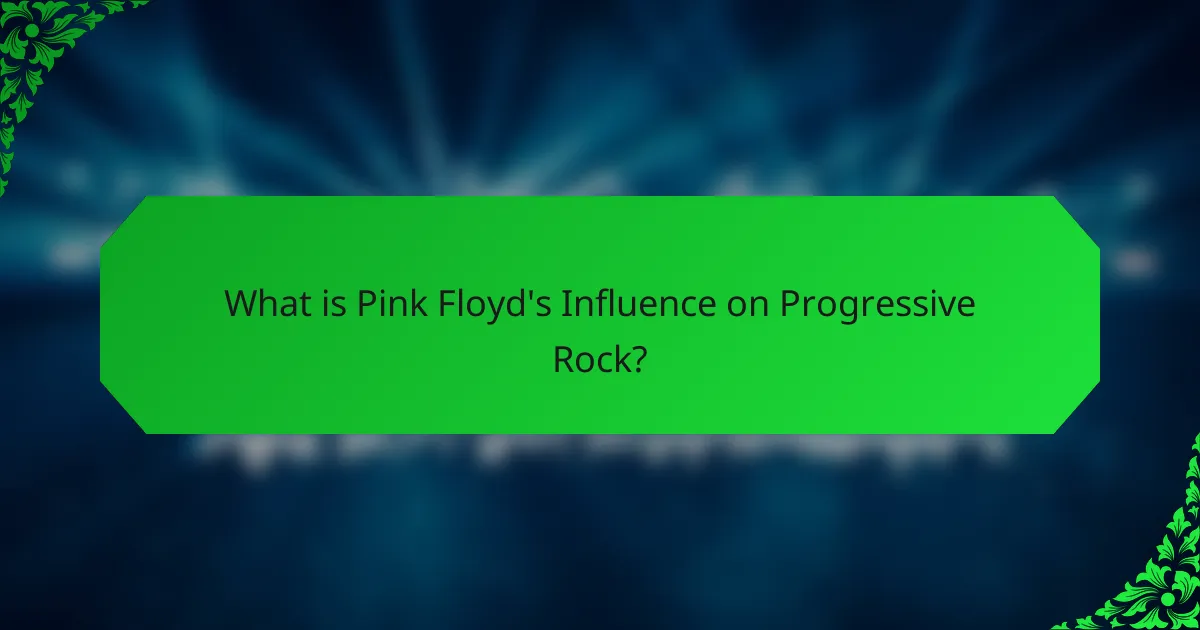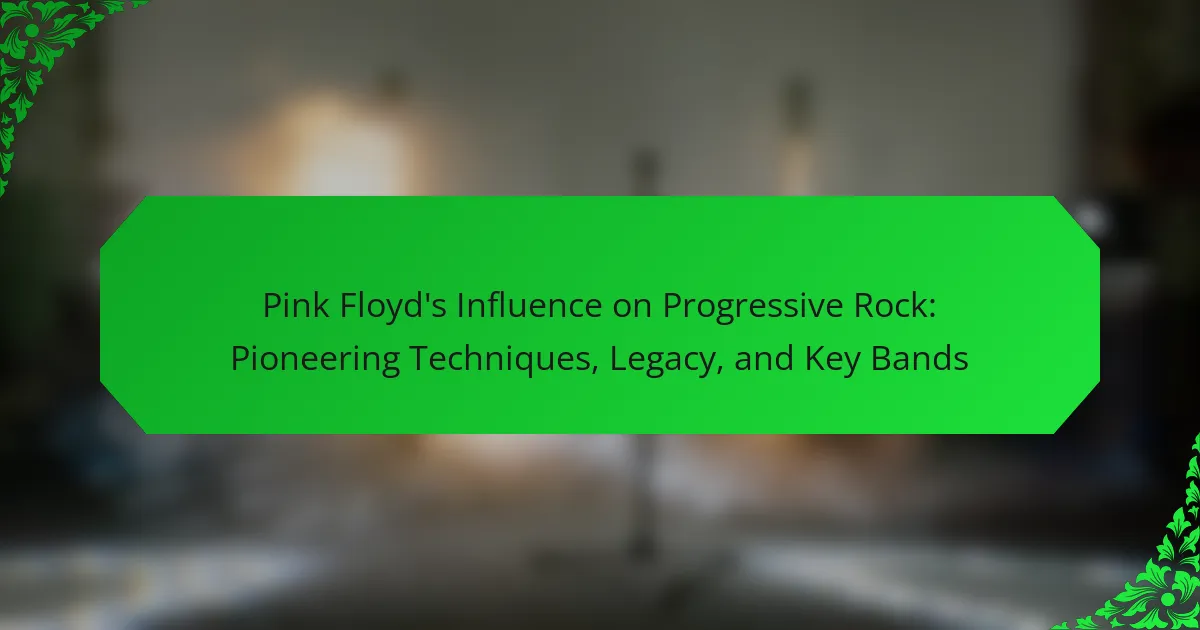Pink Floyd is a seminal band in the progressive rock genre, recognized for their innovative sound and conceptual albums. Their groundbreaking techniques in music production, particularly in the album “The Dark Side of the Moon,” established new standards for seamless transitions and immersive listening experiences. Pink Floyd’s thematic exploration of existentialism and societal issues resonated deeply with audiences and influenced a wide range of artists, including key bands like Radiohead, Tool, and Porcupine Tree. Their elaborate live performances, which integrated visual art and storytelling, further shaped the progressive rock movement and continue to inspire musicians across various genres today.

What is Pink Floyd’s Influence on Progressive Rock?
Pink Floyd significantly influenced progressive rock through their innovative sound and conceptual albums. Their use of experimental studio techniques, such as multi-track recording and tape manipulation, set new standards in music production. The album “The Dark Side of the Moon” showcased seamless transitions between tracks, creating an immersive listening experience. This album spent over 900 weeks on the Billboard charts, highlighting its impact. Additionally, Pink Floyd’s thematic focus on existentialism and societal issues resonated with the progressive rock ethos. Their elaborate live shows incorporated visual art and storytelling, influencing future performances in the genre. Bands like Genesis and Yes cited Pink Floyd as a major inspiration for their own musical explorations. Overall, Pink Floyd’s contributions helped define the progressive rock movement and continue to inspire artists today.
How did Pink Floyd shape the sound of progressive rock?
Pink Floyd significantly shaped the sound of progressive rock through their innovative use of studio technology and conceptual themes. Their album “The Dark Side of the Moon” introduced seamless transitions between tracks, creating a cohesive listening experience. This album also featured complex time signatures and synthesizers, which became hallmarks of the genre. Additionally, their incorporation of philosophical lyrics and sound effects added depth to their music. Pink Floyd’s live performances included elaborate visual elements, enhancing the overall experience. Their influence can be seen in the works of later progressive rock bands, such as Genesis and Yes. The band’s experimental approach pushed the boundaries of traditional rock music, solidifying their legacy in the genre.
What are the key musical elements introduced by Pink Floyd?
Pink Floyd introduced several key musical elements that significantly shaped progressive rock. They are known for their innovative use of concept albums. “The Dark Side of the Moon” exemplifies this, presenting a cohesive narrative throughout its tracks. Their incorporation of extended instrumental passages is another defining feature. Songs like “Echoes” showcase their ability to blend musical improvisation with structured composition.
Additionally, Pink Floyd utilized advanced studio techniques. They employed sound effects and tape manipulation to create immersive soundscapes. Their use of synthesizers was groundbreaking, as seen in “Wish You Were Here.” The band also experimented with time signatures and complex rhythms, enhancing the depth of their music.
Their lyrical themes often explored existentialism and human experience, adding a philosophical layer to their work. Overall, Pink Floyd’s contributions to musical structure, technology, and thematic depth have left a lasting impact on the genre.
How did their lyrical themes contribute to the genre?
Pink Floyd’s lyrical themes significantly shaped the progressive rock genre. Their exploration of existentialism, mental health, and societal issues resonated deeply with listeners. The album “The Dark Side of the Moon” addressed topics like time and madness, influencing countless artists. Additionally, their use of narrative storytelling in songs created immersive experiences. This thematic depth encouraged other bands to adopt similar approaches. Their focus on abstract concepts set a precedent for lyrical complexity in progressive rock. Ultimately, Pink Floyd’s themes expanded the genre’s emotional and intellectual scope.
Why is Pink Floyd considered a pioneering band in progressive rock?
Pink Floyd is considered a pioneering band in progressive rock due to their innovative musical techniques and conceptual albums. They were among the first to integrate elaborate soundscapes with philosophical lyrics. Their 1973 album, “The Dark Side of the Moon,” is a landmark in the genre, featuring seamless transitions between tracks and a focus on thematic coherence. The band utilized advanced studio technology, such as multitrack recording and synthesizers, to create unique sounds. Their live performances often included visual elements, enhancing the overall experience. Pink Floyd’s influence is evident in the works of many subsequent progressive rock bands. They set a standard for artistic expression in music that transcended traditional rock boundaries.
What innovative techniques did Pink Floyd use in their music?
Pink Floyd used several innovative techniques in their music, including extended compositions and concept albums. They were pioneers in the use of synthesizers, which added unique soundscapes to their tracks. Their album “The Dark Side of the Moon” featured seamless transitions between songs, creating a continuous listening experience. They incorporated sound effects and tape loops, enhancing the auditory experience. The band also utilized complex time signatures and unconventional song structures. Additionally, they integrated visual elements into their live performances, creating a multi-sensory experience. Their innovative approach influenced countless artists in the progressive rock genre and beyond.
How did their album structure differ from traditional rock?
Pink Floyd’s album structure differed from traditional rock by emphasizing thematic coherence and extended compositions. Unlike traditional rock albums, which often featured standalone tracks, Pink Floyd’s works were designed as cohesive narratives. Their albums often included long instrumental passages and seamless transitions between songs. For example, “The Dark Side of the Moon” flows continuously without distinct breaks between tracks. This approach allowed for deeper exploration of concepts and emotions. Additionally, their use of sound effects and experimental techniques created an immersive listening experience. Overall, Pink Floyd’s structure prioritized artistry and concept over commercial single-driven formats.

What is the legacy of Pink Floyd in the music industry?
Pink Floyd’s legacy in the music industry is profound and multifaceted. They are recognized as pioneers of progressive rock. Their innovative use of sound effects and studio techniques set new standards. The album “The Dark Side of the Moon” is one of the best-selling albums of all time. It spent over 900 weeks on the Billboard charts. Their elaborate live shows integrated visual arts with music. This approach influenced countless artists and bands. Pink Floyd’s exploration of complex themes resonated with audiences globally. Their impact is evident in the music of later genres, including alternative and electronic music.
How has Pink Floyd influenced subsequent generations of musicians?
Pink Floyd has significantly influenced subsequent generations of musicians through their innovative sound and conceptual approach. Their pioneering use of technology in music production set new standards. The album “The Dark Side of the Moon” showcased advanced recording techniques and thematic cohesion. This album has sold over 45 million copies worldwide, demonstrating its lasting impact. Many artists cite Pink Floyd’s emphasis on atmosphere and storytelling as key inspirations. Bands like Radiohead and Tool have adopted similar experimental sounds. Additionally, Pink Floyd’s incorporation of visual elements in live performances has influenced the staging of modern concerts. Their legacy continues to shape the creative direction of contemporary music.
What notable bands cite Pink Floyd as an inspiration?
Notable bands that cite Pink Floyd as an inspiration include Radiohead, Muse, and Tool. Radiohead has acknowledged Pink Floyd’s influence on their atmospheric sound and lyrical themes. Muse incorporates progressive rock elements reminiscent of Pink Floyd in their music. Tool has drawn from Pink Floyd’s complex song structures and conceptual albums. These bands have publicly expressed admiration for Pink Floyd’s innovative approach to music. Their work reflects the lasting impact of Pink Floyd on the progressive rock genre.
How have Pink Floyd’s albums impacted the concept of concept albums?
Pink Floyd’s albums have significantly shaped the concept of concept albums. Their work, particularly “The Dark Side of the Moon” and “The Wall,” introduced cohesive narratives throughout entire albums. These albums explored complex themes such as mental illness, war, and existentialism. The seamless transitions between tracks created a unified listening experience. This approach influenced countless artists in various genres to adopt similar storytelling techniques. Additionally, Pink Floyd’s use of innovative soundscapes and studio techniques set a new standard for album production. Their emphasis on artistic expression over commercial appeal redefined the expectations of what an album could achieve. The band’s legacy continues to inspire musicians to craft albums with deeper meanings and interconnected narratives.
What cultural impact did Pink Floyd have beyond music?
Pink Floyd had a significant cultural impact beyond music through their exploration of themes such as mental health, war, and existentialism. Their album “The Wall” addressed issues of isolation and psychological trauma. This resonated with audiences, leading to discussions about mental health awareness. Additionally, their innovative use of visual art in live performances influenced the aesthetics of concert presentations. Pink Floyd’s incorporation of elaborate light shows and projections set a standard for future artists. Their music also inspired various forms of art, including literature and film. The film “Pink Floyd: The Wall” further expanded their narrative into cinema, blending visual storytelling with music. Overall, Pink Floyd’s artistic vision transcended their musical contributions, affecting broader cultural conversations and artistic expressions.
How did their visual performances change live music experiences?
Pink Floyd’s visual performances transformed live music experiences by integrating elaborate light shows and multimedia elements. Their innovative use of projections and stage designs created immersive environments. This approach elevated the concert experience beyond just music. Audiences engaged with a synchronized blend of sound and visual art. The band’s iconic performances, such as “The Wall,” showcased this integration effectively. Such experiences set new standards for live shows in the music industry. Other bands began adopting similar techniques, influenced by Pink Floyd’s success. This shift led to a broader acceptance of visual artistry in live music.
What role did Pink Floyd play in the evolution of album art?
Pink Floyd significantly influenced the evolution of album art through innovative designs and concepts. Their album “The Dark Side of the Moon,” released in 1973, featured a minimalist design by Storm Thorgerson. This iconic prism image became a symbol of the band and is recognized worldwide.
The band also embraced thematic visuals that complemented their music’s narrative depth. For instance, “Wish You Were Here” used stark imagery to convey feelings of absence and alienation.
Their collaboration with Hipgnosis, a design group, set a standard for conceptual album art. This partnership resulted in visually striking covers that enhanced the listening experience.
Pink Floyd’s use of elaborate gatefold designs and immersive packaging further transformed how albums were presented. They integrated visual storytelling into their music, influencing countless artists and the industry as a whole.
Overall, Pink Floyd’s approach to album art elevated it to an essential aspect of the music experience, merging visual and auditory artistry.

Which key bands were influenced by Pink Floyd?
Key bands influenced by Pink Floyd include Radiohead, Tool, and Porcupine Tree. Radiohead’s sound evolved significantly after incorporating experimental elements similar to those of Pink Floyd. Tool is known for their complex compositions and thematic depth, reflecting Pink Floyd’s influence. Porcupine Tree blends progressive rock with ambient soundscapes, drawing inspiration from Pink Floyd’s atmospheric style. Other notable mentions are Dream Theater and Muse, both of which exhibit characteristics reminiscent of Pink Floyd’s innovative approach to music.
What are some notable progressive rock bands that followed Pink Floyd?
Notable progressive rock bands that followed Pink Floyd include Genesis, Yes, and King Crimson. Genesis gained prominence in the 1970s with albums like “The Lamb Lies Down on Broadway.” Yes became known for their complex compositions and harmonies, particularly in “Fragile” and “Close to the Edge.” King Crimson, with their seminal album “In the Court of the Crimson King,” pushed the boundaries of the genre. Other influential bands include Emerson, Lake & Palmer and Jethro Tull, both known for their unique blends of rock and classical music elements. These bands expanded the progressive rock landscape, building on the innovations introduced by Pink Floyd.
How did Genesis incorporate Pink Floyd’s techniques in their work?
Genesis incorporated Pink Floyd’s techniques primarily through their use of atmospheric soundscapes and complex compositions. They adopted extended instrumental passages, creating immersive experiences similar to Pink Floyd’s style. Genesis also utilized thematic storytelling in their lyrics, akin to the narrative approach of Pink Floyd. The band’s incorporation of synthesizers and innovative studio techniques mirrored Pink Floyd’s experimental sound. Additionally, both bands shared a penchant for elaborate live performances that emphasized visual elements. Genesis’s album “The Lamb Lies Down on Broadway” reflects these influences with its conceptual depth and sonic exploration. This connection highlights the significant impact Pink Floyd had on Genesis’s musical evolution and the broader progressive rock genre.
In what ways did Porcupine Tree draw inspiration from Pink Floyd?
Porcupine Tree drew inspiration from Pink Floyd through their use of atmospheric soundscapes. They incorporated lengthy instrumental passages similar to Pink Floyd’s style. Porcupine Tree also embraced conceptual themes in their albums, reflecting Pink Floyd’s narrative approach. Their music often features intricate guitar solos reminiscent of David Gilmour’s work. Additionally, both bands share a penchant for blending progressive rock with elements of psychedelia. Porcupine Tree’s album “The Sky Moves Sideways” showcases these influences explicitly. The band’s exploration of existential themes parallels those found in Pink Floyd’s discography. This connection highlights the significant impact Pink Floyd had on Porcupine Tree’s musical evolution.
What are the defining characteristics of bands influenced by Pink Floyd?
Bands influenced by Pink Floyd often feature atmospheric soundscapes and intricate compositions. They typically incorporate progressive rock elements such as extended instrumental sections. Many bands emphasize lyrical depth, exploring themes of existentialism and human experience. Additionally, these bands frequently use innovative studio techniques, including sound effects and multi-layered production. Visual elements, such as elaborate live shows and artwork, are also a common characteristic. The influence of concept albums is evident in their work, mirroring Pink Floyd’s approach. Bands like Porcupine Tree and Radiohead exemplify these traits, showcasing the lasting impact of Pink Floyd’s musical legacy.
How do these bands reflect Pink Floyd’s approach to composition?
Many bands reflect Pink Floyd’s approach to composition through their use of atmospheric soundscapes. For example, bands like Porcupine Tree and Radiohead incorporate extended instrumental sections. They often blend rock with experimental elements, mirroring Pink Floyd’s style. The narrative-driven lyrics in their songs also echo Pink Floyd’s thematic depth. Additionally, these bands utilize concept albums, a hallmark of Pink Floyd’s discography. They explore complex musical structures, often shifting time signatures and dynamics. This mirrors Pink Floyd’s innovative arrangements and progressive rock foundations. Overall, their compositional techniques demonstrate a clear influence from Pink Floyd’s legacy.
What common themes are present in the music of these bands?
Common themes in the music of these bands include existentialism, introspection, and societal critique. These themes often explore human experience and emotions. Many songs delve into mental health and personal struggles. The use of surreal imagery is also prevalent. Additionally, concepts of time and space frequently appear in the lyrics. The music often features complex arrangements and extended compositions. This complexity reflects the emotional depth of the themes. Bands influenced by Pink Floyd often incorporate these elements into their own work.
What practical insights can we gain from Pink Floyd’s influence on progressive rock?
Pink Floyd’s influence on progressive rock provides insights into innovative soundscapes and thematic depth. Their use of extended compositions transformed song structures in the genre. Albums like “The Dark Side of the Moon” showcased seamless transitions between tracks. This approach inspired bands to explore narrative-driven music. Pink Floyd’s incorporation of synthesizers and effects broadened sonic possibilities. Their visual artistry set a standard for live performances. The band’s exploration of existential themes resonated with audiences, deepening emotional connections. These elements collectively shaped the evolution of progressive rock.
Pink Floyd is the primary entity discussed in the article, focusing on their significant influence on the progressive rock genre. The article outlines Pink Floyd’s innovative techniques, such as the use of concept albums, advanced studio technology, and elaborate live performances, which helped define the sound and structure of progressive rock. It highlights the thematic depth of their lyrics, exploring existentialism and societal issues, and discusses their lasting legacy and inspiration for subsequent bands like Genesis, Radiohead, and Tool. Overall, the article emphasizes Pink Floyd’s pioneering contributions and their profound impact on the evolution of music within the progressive rock movement.
